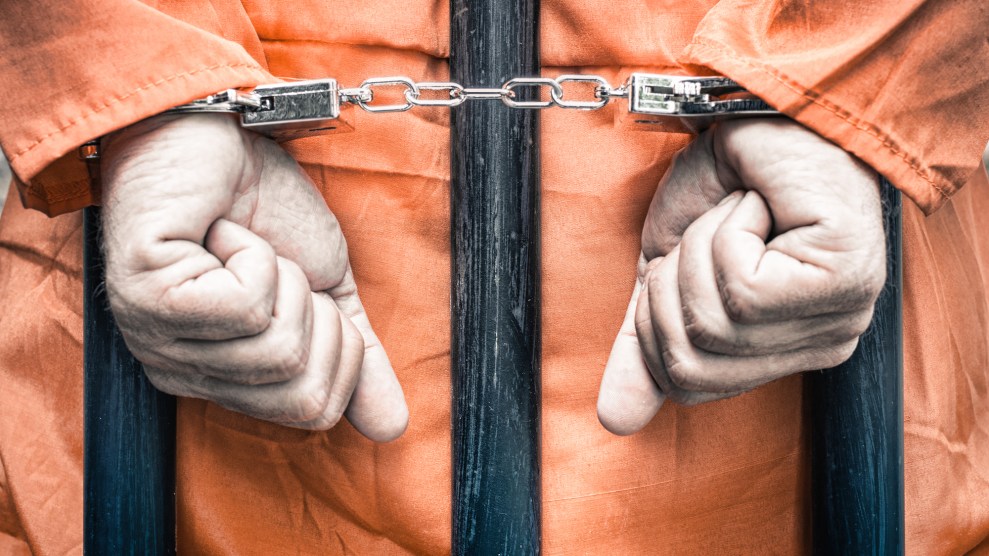
ViewApart/Getty Images
On Valentine’s Day at one of Kansas’ largest state prisons, the new Democratic governor, Laura Kelly, stood before a room of corrections officers in body armor and black polos and begged them not to leave their jobs. “I know it’s asking a lot when I ask you to hang in there,” Kelly told the prison employees, according to the Wichita Eagle. “Please don’t quit.” One staffer blinked sleepily as she spoke. A few onlookers rested their heads in their hands.
Just days before Kelly’s visit, the leader of the Kansas Department of Corrections (KDOC) had declared a state of emergency at the site, the El Dorado Correctional Facility. The maximum-security prison used to hold around 1,500 inmates, but for years, KDOC had been cramming extra beds into cells. By the time of the emergency declaration last month, the strained prison had more than 2,000 people in lockup, all while operating under a severe staff shortage—84 uniformed positions and 11 others were unfilled. Corrections officers had long been stretched thin, growing increasingly desperate as their eight-hour shifts lengthened to 12 hours, then 16. They were falling asleep at work, forgetting to lock doors, and, ultimately, quitting in droves as they failed to square their long hours with uncompetitive paychecks. The prisoners, meanwhile, took control of parts of the prison at least three times since 2017, setting fires, breaking windows, and occupying the yard.
The problems in Kansas’ prison system aren’t limited to a single site. According to KDOC chief Roger Werholtz, who was appointed by Kelly in January, they’re endemic: not enough guards, not enough inmate programming, not enough behavioral health care. Many of the problems trace back years, to former Kansas Gov. Sam Brownback, a Republican who turned the state into a laboratory for right-wing economic policies. His grand tax-cutting experiment, intended to fire up the economy after the Great Recession, ended up decimating state revenues, hobbling growth, and forcing cuts across agencies. Most public attention during the period focused on the resulting underfunding of the state’s public education system, but the cuts also landed on prisons—at a time when the state’s inmate population was starting to creep up due to increasing incarceration of people who violate probation.
“The Department of Corrections, just like a lot of other state agencies, has been hollowed out,” Werholtz says. “Whether you’re looking at substance abuse treatment, sex offender treatment, cognitive behavioral…we are only able to treat a fraction of the population that needs those kinds of interventions.”
Now Kelly and her allies are charged with cleaning up the mess. But first, they have to deal with another headache: Before Kelly and Werholtz took office, Brownback and Republican legislators approved a controversial and unprecedented agreement to hire CoreCivic, one of the country’s two largest private prison companies, to build a prison 30 minutes outside Kansas City and rent it back to the state for two decades. Now Kansas is locked into a deal that has proven millions of dollars more expensive than it had planned—and that promises to breathe new life into CoreCivic and the troubled private prison industry.
Werholtz is an old-timer at KDOC. He ran the agency for eight years, overseeing a declining inmate population and some prison closures, before retiring in 2010. He returned to KDOC as interim secretary this year to rescue what he calls an “agency under stress.” Brownback approved around $5 million in budget reductions to the department in 2013 and continued to threaten millions more in cuts. Now, Werholtz’s department is missing 411 employees across eight state prisons. More than half its guards have less than two years of experience. Health and behavioral services are also severely lacking: In 2018, 54 percent of offenders who needed substance abuse programming did not receive it before release; the same was true for 27 percent of people who needed sex offender treatment. Of 600 inmates who recently tested positive for Hepatitis C, the state says it can only afford to immediately treat 43.
Along with the staffing and budget problems, Werholtz also inherited the first-of-its-kind deal to outsource the rebuilding of a massive state prison. The agreement goes back to 2017, when KDOC requested bids to replace the Civil War-era Lansing Correctional Facility. Nearly everyone—Republicans and Democrats—agreed the site was in dire straits; after a tour, state Senate President Susan Wagle (R-Wichita) told the Topeka Capital-Journal that she couldn’t “erase from my mind the conditions that prisoners were living under,” calling the prison “deplorable” and “unsafe.” Parts of the interior reach 110 degrees in summer. In one cell house, the locks are so unreliable that prisoners can leave “basically when [they] choose,” says KDOC director of capital improvements Mike Gaito.
Werholtz says his predecessor was told, “There’s no money to build a new prison. If you can figure out a way to build it without a budget increase, go ahead.” The state could have issued up to $155 million in bonds to pay for a replacement prison—an option an audit determined to be the most cost-effective choice. But KDOC argued that $155 million was an outdated estimate and wouldn’t be enough to cover construction of a new prison to house 2,432 inmates of all security levels. So the agency instead chose to partner with CoreCivic, which would take on the building costs and then act as a landlord and lease the prison to the state. The State Finance Council, which included Brownback and top legislators, then voted to approve the deal. (It didn’t hurt that CoreCivic had hired two former Brownback staffers as lobbyists.)
The agreement stipulates that CoreCivic will build the new Lansing Correctional Facility on the site of the old prison—at an apparent cost of $159.5 million, or just slightly more than the state had originally estimated it might spend if it built the prison itself. The company will own and maintain the prison and rent it back to the state, in exchange for an estimated $362 million in lease, maintenance, and insurance payments over 20 years. KDOC, not CoreCivic, will manage day-to-day operations. At the end of the lease, the state will take ownership of the facility.
The deal, on its surface, probably seemed like a win-win to the financially stressed state government. In a presentation to legislators before the deal was made, KDOC claimed that beyond saving the state upfront construction costs, the department wouldn’t need any additional appropriations to make its rent payments. In fact, KDOC projected it’d be saving millions. Initial estimates showed that the project would save more than $23 million over 20 years, as compared to keeping the old prison open. The key was that KDOC, long-troubled by its inability to hire and retain guards and other prison personnel, would staff the new prison with only about half as many employees as the old one—saving more than $17 million, which KDOC could then use toward its lease payments.
It was a radical claim: that the new Lansing Correctional Facility, which would hold about 100 more prisoners than the old one, could cut its personnel from 682 to 371 and still keep inmates and guards safe. KDOC said it could make it work through a combination of state-of-the-art architectural design and technology, including modern surveillance cameras and door controls that actually work. (“Locking systems that work reliably are an advance in technology for us in that facility,” Werholtz says. “It’s—an interesting situation.”) A key component, KDOC told state auditors, would be modern, square housing “pods” with a guard station in the middle, rather than the old Lansing prison’s long, linear cell blocks; the pod design requires fewer correctional officers to keep watch.
Yet, with construction at Lansing underway for 11 months, it has become clear that some of KDOC’s plans simply won’t work. There wasn’t actually enough space to build square housing pods on the current plot of land, so many inmates will be kept in the same kind of long cell blocks as the old prison. That’s “not the optimal design,” Werholtz says. He’s worried about lines-of-sight for guards stationed at the far end of each housing unit, and also frets about the plan to keep maximum-security inmates in two-person cells; he believes the practice contributed to uprisings at El Dorado and other lockups in recent years.
The design problems mean that KDOC’s original plan—to afford lease payments and produce savings by cutting staff—will not in fact work exactly as planned. After Werholtz toured the construction site in late February, KDOC determined that at least 33 additional employees, including both uniformed staff—guards and counselors—and administrators, would be needed to properly supervise the housing units and keep the prison running. The new staffing projections will require additional up-front appropriations and reduce the project’s overall estimated savings from $23.6 million to just $1.3 million over 20 years.
Gov. Kelly has long been critical of the deal with CoreCivic. Back in 2017, before it was approved and she was still a state senator, she claimed that KDOC’s plan hadn’t been fully thought through. She argued that it was already creating chaos in the prison system, as inmates were transferred out of Lansing prior to construction. After taking office in January, she told the Associated Press, “We were just, you know, hoodwinked, I think.”
At the end of the day, CoreCivic will get paid and make out with an undisputed win. “The project remains on-budget,” spokesperson Amanda Gilchrist said in a statement to Mother Jones. “When finished, the project, which will be accredited by the American Correctional Association, will provide a state-of-the-art facility with enhanced safety and security, as well as programming space for rehabilitation of inmates.”
By becoming a long-term landlord for government agencies like KDOC, the company is ensuring a cash flow for decades—which is particularly crucial as the private prison industry faces threats to its long-term profitability, including changing attitudes toward mass incarceration, declining prison populations, and the souring of public opinion regarding private prisons and detention centers. “The private prison industry, at least before the election of Donald Trump, was really rethinking its strategy,” explains Bob Libal, executive director of the anti-private prison advocacy group Grassroots Leadership. Now it seems very likely that additional arrangements like the one at Lansing will be a part of the company’s longterm plans.
In one sense, the shift toward private prison companies becoming government landlords fulfills a promise made in 2013, when top private prison companies converted from traditional corporations into Real Estate Investment Trusts. The move allowed them to avoid paying taxes on revenue from real estate, while passing more of their profits onto shareholders. Now, income made from prisons and detention centers goes largely untaxed. “By claiming that their primary business is not the caging of human beings, but it’s the owning of the land under the cages, then the companies can save millions of dollars in taxes,” Libal says, “and reinvest that money in more land to build more cages on.”
Beyond real estate, CoreCivic and its main competitor, the GEO Group, have been trying to diversify in other sectors. (CoreCivic literally rebranded, changing its name in 2016 from the more-descriptive “Corrections Corporation of America.“) They’ve snatched up ankle monitoring companies, halfway houses, and parole resource centers, as well as some non-prison-related real estate, which they then lease back to government agencies.
They’ve even gone so far as to publicly support the First Step Act, a modest criminal-justice reform bill that shortened some federal sentences, and which could potentially push more inmates into their growing networks of halfway houses and reentry centers. “Helping people get their lives back on track is at the core of our purpose to better the public good,” Gilchrist told the Tampa Bay Times. (CoreCivic has similarly spun the Lansing deal as a public good: “There are also meaningful societal benefits when jurisdictions choose to address their aging, outdated correctional infrastructure,” CEO Damon Hininger said in a February earnings call. “This is a critical infrastructure problem across the country, and we believe the solutions offered by CoreCivic Properties—shown in our solution signed in 2018 for the state of Kansas—are the key to addressing these long-standing challenges.”)
In Libal’s view, the companies are attempting to “hijack” the criminal-justice reform movement in order to secure long-term profits. “They’re looking at how to rebrand,” he says. “Sort of saying, ‘We’re not a prison operations company, we’re a real estate firm that also does treatment—and we also have some, you know, prison facilities.'”
“But the vast majority of the money is still in prisons,” he adds. “That should be clear.”
Last month, Hininger told investors that CoreCivic is turning its sights next to Alabama, where Republican Gov. Kay Ivey recently announced the state would seek bids to build three new prisons for men, at a cost of around $900 million. (Like Kansas, the state is also facing massive staffing shortages; it’s under a court order to double its number of guards in the next two years.) Alabama’s corrections commissioner Jeff Dunn said his agency has “no plans” to ask for additional appropriations to build the prisons. Like Kansas, they’re going to try to do it without increasing the prison system’s budget. The options? To issue bonds, or to sign a Lansing-style private-prison contract, according to AL.com.
Meanwhile in Kansas, following an unusually frank briefing by Werholtz in January, lawmakers are incredulous that they’re just now learning the full extent of problems in the state’s prison system—including the severity of staffing vacancies and details about the riots that have swept state prisons over the past few years. They’re considering a bill that would create a criminal justice reform commission to analyze sentencing laws and and potentially seek ways to reduce the prison population. To deal with the immediate staffing problems at El Dorado, Werholtz has talked with lawmakers about shutting down a whole cell house in the overcrowded prison. He’s even floated the idea of sending some inmates to private facilities while the state sorts out its problems.
At the same time, construction on the new Lansing prison continues apace. “KDOC does not plan at this time to request any changes to its agreement with CoreCivic,” department spokesperson Cheryl Cadue says. A minimum-security unit is scheduled to be completed in October; the medium and maximum security unit in January 2020.
“It’s always easy to talk about getting tough on crime,” Werholtz says. “But nobody ever talks much about the cost, or the return on investment. And I think our folks here in Kansas are starting to ask those questions again.”

















